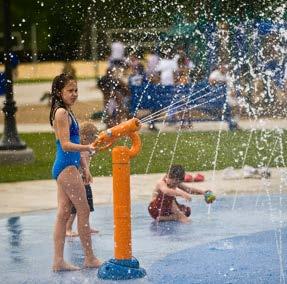

Forney Parks & Trails Master Plan
ADOPTED JUNE 4th, 2024
CITY OF FORNEY, TEXAS
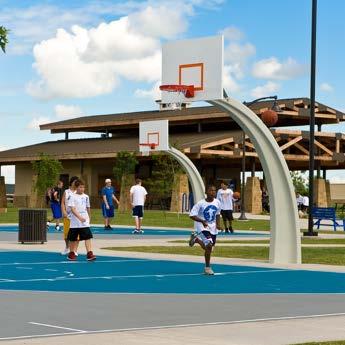
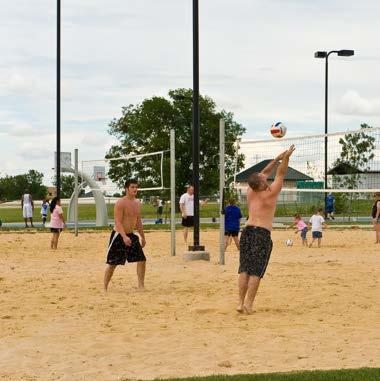

Acknowledgments
CITY COUNCIL
Jason Roberson, Mayor
James Traylor, Place 1
Cecil Chambers, Place 2
Sandi Primous, Place 3
Sarah Salgado, Mayor Pro Tem, Place 4
Zahnd Schlensker, Place 5
Greg Helm, Place 6
PARKS & REC BOARD
Kris Briggs
Nate Dettmer (Chairman)
Obed Centeno
Diane McPherson
Alexa Beasley, (Vice-Chairman)
Deidra Henry
Cory Wiggins
KEY CITY STAFF
Kyle Rouvaldt – Director of Parks & Recreation

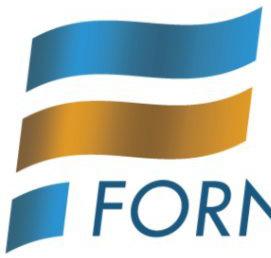
David Hokett – Assistant Director of Parks & Recreation
Dodie Witt – Sports Coordinator
Kevin McCarthy – Recreation Assistant
Ricky Hoelscher – Special Events Coordinator
THE CITIZENS OF FORNEY
CONSULTANT
Parkhill

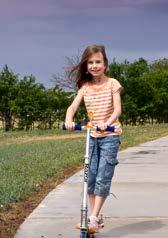
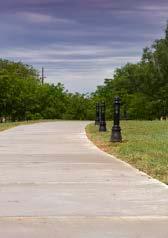
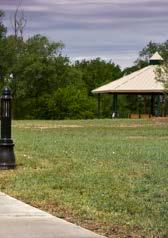




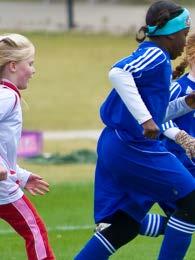
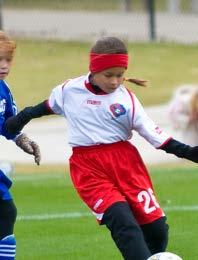
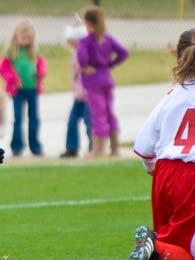



APPENDIX
-
FACILITIES INVENTORY & CONDITIONS ASSESSMENT
A great parks system makes a great city. The Forney Parks & Trails
Master Plan will be a practical guide for policy and decision-making related to the availability, type, scale and location of park and recreation opportunities to meet the needs of Forney residents and visitors.

PREFACE
The Forney Park & Trails Master Plan outlines a network of parks and trails to be improved or established gradually. The proposed amenities in this strategy prioritize establishing a cohesive park and trail system that is easily accessible, wellintegrated, and caters to both local and regional preferences. It marks the City’s third comprehensive plan for parks and trails and will serve as a blueprint for future project execution and municipal budget allocation.
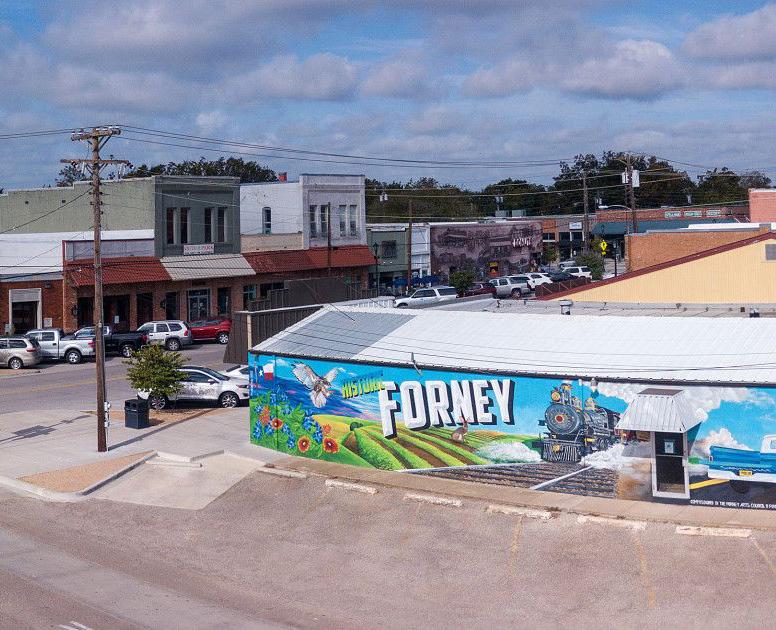
Benefits of Master Planning

THE BENEFITS OF MASTER PLANNING
Parks, trails, and recreation amenities and programs are an essential public good for residents and visitors by enhancing their quality of life. They provide socioeconomic benefits, including a positive impact on public health, economic development, and the preservation of and accessibility to the natural environment. A successful park system works to ensure that all interests, both public and private, are aligned in development and programming for the growth and prosperity of the citizens it serves.
The purpose of the Forney Parks, Trails, Master Plan Update is to replace the existing 2014 Parks and Trails Master Plan by assessing the community’s current and future needs for improving its parks, trails, and recreation system and to provide for areas and facilities to meet both the short and long-term needs of the community. The Master Plan Update is a guide for policy and decision-making related to the location, type, scale, and quality of park, trail, and recreation opportunities to meet the needs of Forney residents and visitors. The plan considers the needs and priorities based on the current and projected population and development within the City of Forney and its surrounding area.
The purpose of this update to the 2014 Parks and Trails Master Plan is to:
| Determine current and future needs for improving and updating existing parks and trails network.
| Generate more user buy-in by involving the communityat-large, their leaders and other stakeholders in setting attainable priorities and goals for the parks, trails, and recreation system.
| Provide an up to date, easy to understand prioritized action agenda to guide decision makers (current and future) in designing, developing, upgrading, and maintaining the parks and recreation system for all Forney residents.
| Provide current information on available grants and other external funding opportunities and a garnering support for local funding options.
| Lastly, align with the City’s comprehensive plan, Future Forney and linking it to support and enhance broader objectives towards the development of Forney while preserving the natural environment and community culture.
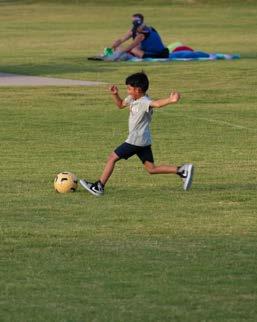
The process of the Parks and Trails Master Plan update for Forney started in May 2023 with an inventory and assessment of existing facilities – including but not limited to – city-owned parkland, established parks and trails. Monthly meetings were established with City Staff through the duration of the project. The plan was a community wide effort through two public meetings, two online surveys, and four (4) meetings with Parks Board and two (2) with City Council. The City currently has a Parks and Recreation department with twenty-one (21) full-time employees, and one (1) part time employee, and they currently operate both youth and adult leagues. As needs and opportunities are discovered, this plan will serve as a guide to establish those initiatives which can be incorporated into the City’s planning and budgeting process.
This plan adheres to the guidelines of the Texas Parks and Wildlife Grants-in-Aid Division for the preparation of this Master Plan. (See matrix in appendix).
1.2 Community Context

REGIONAL LOCATION
The City of Forney is located along US Highway 80 in the northwestern portion of Kaufman County. It closely neighbors Rockwall County and Dallas County and is approximately 22 miles east of downtown Dallas and 14 miles from downtown Rockwall.
Forney, Kaufman County, and Texas at large, continue to experience significant and rapid population growth. Kaufman County is just due east of Dallas County and serves as a prime location for residents who desire a suburban or more rural setting accessible to high quality jobs and urban amenities.
The trend of buildout from the DFW Metroplex urban core to the surrounding suburbs continues to boom. As development happens around Forney, planning for undeveloped parkland, trails and intended open space will be needed.
KAUFMAN
KAUFMAN
ROCKWALL DALLAS

POPULATION & DEMOGRAPHICS
POPULATION PROJECTION
Population projections were developed out to the year 2040. Two of the four projections used were based off the latest comprehensive plan (Future Forney) and all were calculated using the latest data from the U.S. Census Bureau. Understanding the population and growth projection is key to understanding the potential number of residences, transportation networks, and infrastructure needed for the future. This includes park land as well as trails.
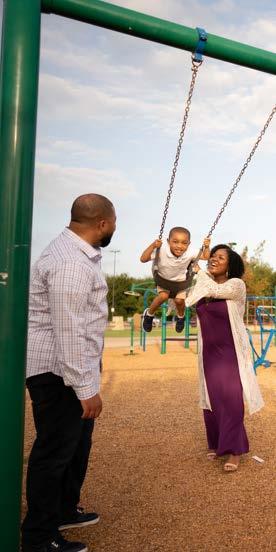
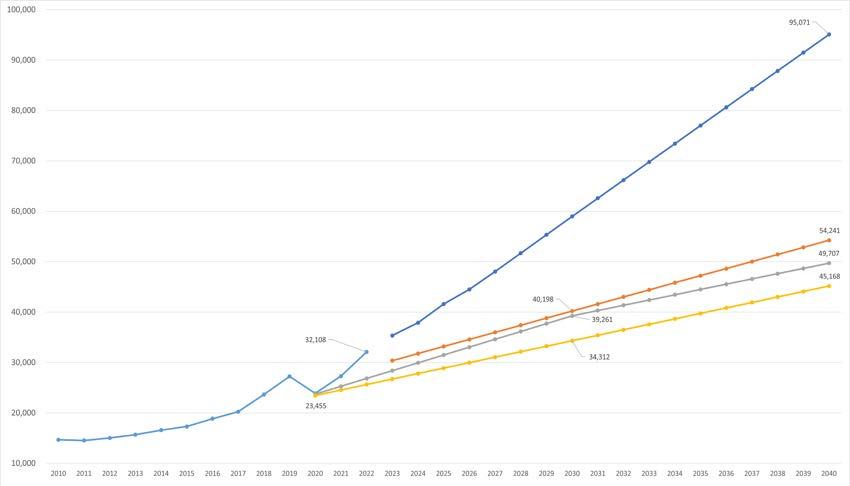
AGE & GENDER
Age and gender are important to understand the current conditions and preferences of activities, civic centers, parks and other infrastructure needs to support aging in place. The US Census Bureau estimates that Forney’s majority population is between 30 and 39 years of age. As noted in the 2023 Comprehensive Plan, there is a higher concentration of under 18 in the northeastern region of Forney and its ETJ (also of note, there is new residential development) and the highest concentration of Forney’s population over 65 is located along the western portion of Forney and its ETJ.
Under 5 Years
5 to 9 Years
10 to 14 Years
15 to 19 Years
20 to 24 Years
25 to 29 Years
30 to 34 Years
35 to 39 Years
40 to 44 Years
45 to 49 Years
50 to 54 Years
55 to 59 Years
60 to 64 Years
65 to 69 Years
70 to 74 Years
75 to 79 Years
80 to 84 Years 85 Years and Over

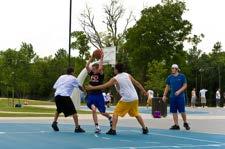

INCOME
The 2023 Comprehensive Plan shows the median household income is $93,792 which is higher than the median for Kaufman County, the Dallas-Fort Worth Metroplex, and the State of Texas. This median income demonstrates a strong economic base that is needed to support recreational tourism, additional retail, and employment services in the City of Forney.
3,000.00
2,500.00
2,000.00
1,500.00
1,000.00
500.00
0.00

RACE & ETHNICITY
The US Census 2021 American Community Survey (ACS) estimates most of the population is 81% white and roughly 83% are non-Hispanic or Latino. Paired with the information provided in the comprehensive plan, this snapshot of the community in its current state assists in understanding the cultural profile of Forney and where it might be trending over the next decade.
Sales
Asian Alone, 2%
American Indian and Alaska Native Alone, 0%
Black or African American Alone, 14%
Some Other Race Alone, 1%
Two or More Races, 2%
Native Hawaiian and Other Pacific Islander Alone, 0%
White Alone, 81%
Sales
Hispanic or Latino, 17%
Not Hispanic or Latino, 83%
FIGURE 4
1.3
Related Studies & Documents

RELATED & PREVIOUS DOCUMENTS
2014
Parks, Recreation, & Open Space
Master Plan
This was an update of Forney’s parks and trails system. The plan was influenced heavily by the community and developed a vision statement to guide the future of Forney’s Parks, Trails, and Open Space:
“Forney provides and promotes an interconnected system of parks, open spaces, recreation facilities and trails to preserve and protect its local heritage, natural resources and community character and to enhance quality of life.”
The goals outlined in this plan were based on the following principles:
| Provide
| Promote
| Protect
| Preserve
From these goal categories, multiple policy recommendations were provided to the City to assist in enhancing and supporting its Parks, Recreation, and Open Space Master Plan.
Future Forney 2023
Future Forney was adopted in early 2023 and consists of guiding principles, goals, and implementation strategies. This comprehensive plan reflects the overarching community values which drive the framework for the future. These guiding principles are:
| Balanced Growth
| Connection
| Community
| Opportunity
| Collaboration
Future Forney discusses several opportunities and community desires within each of the guiding principles as it relates to Parks, Trails, and Open Space.
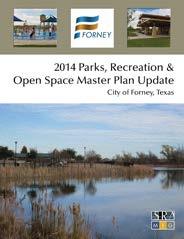
Priority Goals & Objectives

GOALS & OBJECTIVES
Goals and objectives provide the guidance and recommendations for development and implementation of the Forney Parks and Trails Master Plan. The desires expressed by the Forney community are reflected as are the needs in comparison to the data and peer benchmarking. This plan provides direction for multiple entities, developers, and residents to make informed decisions regarding parks, trails, and recreation in Forney. These goals are established for the City of Forney and its extraterritorial jurisdiction.
PRINCIPLES
The Future Forney Comprehensive plan started with guiding principles that reflect the overarching community values and were generated from public input in regard to key themes, challenges and opportunities.
GOALS
Goals are the desired end state according to community’s needs and priorities, reflecting the sentiments of citizens and stakeholders. These goals, formulated from the 2023 Comprehensive Plan, underwent refinement through feedback from the wider community and stakeholder interviews. They were then prioritized by the Parks Advisory Board for strategic implementation. This linkage ensures consistency and fosters community ownership by aligning the goals with the Comprehensive Plan.
Priority Goals, Strategies & Actions
OBJECTIVES
Objectives are the strategies, or actions, used to attain and advance the community’s goals. They are specific, measurable, attainable, relevant, and timebased (SMART). Objectives typically answer “how” the goals are achieved.
The following are the priority goals and objectives for this master plan. The full list of goals and objectives can be viewed in Section Five – Implementation & Funding Resources. As mentioned, the goals and strategies (objectives) were created during the process of the Comprehensive Plan 2023 and built upon and updated through this master planning process to specifically reflect the community and its wants for the parks today and the future. These objectives are the deeper dives that give direction to how the goals will be achieved.
They are supported by actions, items which have been broken into different categories – type of action, timeframe the action is occurring, priority level, cost considerations, the implementing agency, partners, and champions needed to support the efforts and lastly, the drivers, the “why” behind the action item that supports the goal.
These categories below, along with all the goals, strategies, and action items are summarized in the Implementation and Funding section of the report.
Goal for BALANCED GROWTH: Establish an integrated system of parks, trails, and recreation facilities.
Strategy: Design parks to meet the needs of Forney’s residents of all ages and abilities.
Actions to support this effort:
• Pursue location and plans for a new all-inclusive play or park space
• Multipurpose field updates with pavilions for spectators
• Update existing playgrounds and determine appropriate locations for poured-in-place (PIP) safety surfacing to enhance accessibility
• Review, update, and/or create Master Plans for individual parks

Goal to establish better CONNECTION: Further develop the network of sidewalks, trails, and bikeways that connect to key destinations such as parks, schools, areas of employment, and downtown.
Strategy: Create connected trail network.
Actions to support this effort:
• Develop a plan to incorporate the parks land the city already has to extend trail system
• Adopt trail typologies and standards
• Prioritize the priority trails designated in the 2023 Parks & Trails Master Plan with the intent to begin purchasing trail easements
Goal to enhance COMMUNITY: Provide high-quality city facilities at a level of service meeting national standards of excellence to maintain the health, safety, and welfare of all residents.
Strategy: New public facilities should be designed to support the community, be accessible, and create opportunities for social engagement.
Actions to support this effort:
• Reference Parks & Trails Master Plan to determine priority areas and needed facilities for park development.
• Develop master plans / feasibility studies for priority areas and needed facilities for park development.
• Determine stakeholders involved in specific park developments.
• Continue to develop relationship with Forney ISD to collaborate on Opportunity Central (OC) programming that would mutually benefit the Forney Community.
Goal to open doors for OPPORTUNITY: Support downtown as a vibrant destination showcasing Forney's small town character.
Strategy: Extend streetscapes improvements and infill development along Main Street towards Community Park.
Actions to support this effort:
• Create a Main Street Master Plan (between Downtown and Community Park)
• Create a phasing plan for implementation with costs

Goal for COLLABORATION: Utilize intergovernmental partnerships to enhance public services.
Strategy: Continue proactive collaboration and alignment between City of Forney and Forney EDC.
Actions to support this effort:
• Begin discussions on how EDC can provide funding to boost tax base through Parks, Trails, and Open Space initiatives
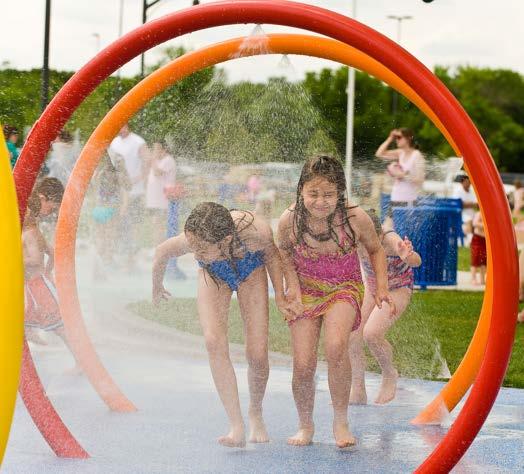
2.0
Understanding existing facility conditions, key features and other programmed areas can assist in prioritizing funding, reimagining of a space and provide quantitative and qualitative data for future development.
Forney Park System Facilities, Programs, & Guidelines
Existing Parks & Trails Classification Guidelines

EXISTING PARKS & TRAILS
CLASSIFICATIONS GUIDELINES
CONCEPTS & GUIDELINES
The Master Plan process formulates standards, also known as guidelines, based off a combination of the goals and objectives, current and future demographics, economic, physical, and other local factors, and conditions. Guidelines are a result of the residents stated wants combined and evaluated through the lens of statewide and national metrics and guidelines as applicable to Forney. These standards were considered when conducting the needs assessment and support the direction of priorities for residents in the implementation portion of the plan.
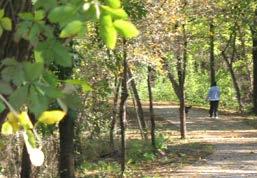
SETTING UP CLASSIFICATIONS & STANDARDS
The National Recreation and Parks Association (NRPA) produces an annual summary report of park facility providers in its annual NRPA Agency Performance Review. There are general metrics in this document to provide a comparison point for existing facilities and future needs as described in the Needs Assessment and prioritization in this plan. The numbers used from NRPA are the most relevant to Forney based off a population of 20,000-49,999 residents. The following three metrics are general community-wide levels of service for park and trail as considered by the NRPA in its 2023 annual summary.
Acres of Parkland per 1,000 residents: 11.3 (median)
Residents per Park: 2,014 (median)
Miles of Trail: 8.0 (median)
UNDERSTANDING NRPA RESOURCES
The NRPA moved away from providing specific park area and facility standards for reasons described in a November 2019 Parks and Recreation Magazine article –“NRPA Park metrics Replaces NRPA Areas and Facilities Standards.” An excerpt taken below explains the reasons for moving away from this:

“Standards” is a word we hear often at NRPA. More specifically, park and recreation professionals ask us about the “NRPA Standards” nearly once a week, and it also came up at the membership booth at this year’s conference. This is impressive because the NRPA Areas and Facilities Standards has not been updated in more than two decades and will never again be updated.
“Standards” is a word we hear often at NRPA. More specifically, park and recreation professionals ask us about the “NRPA Standards” nearly once a week, and it also came up at the membership booth at this year’s conference. This is impressive because the NRPA Areas and Facilities Standards has not been updated in more than two decades and will never again be updated.
The reason for this is simple: There is not a single set of standards for parks and recreation that could possibly encompass the uniqueness found in every community across the country. Communities vary greatly by size, needs and desires; so too should their park and recreation agencies’ offerings. To think an agency in Alaska, one in Kansas and one in south Florida should hold themselves to the same standards is unrealistic, impractical, and potentially detrimental.”
The reason for this is simple: There is not a single set of standards for parks and recreation that could possibly encompass the uniqueness found in every community across the country. Communities vary greatly by size, needs and desires; so too should their park and recreation agencies’ offerings. To think an agency in Alaska, one in Kansas and one in south Florida should hold themselves to the same standards is unrealistic, impractical, and potentially detrimental.”
– Melissa May, Senior Research Manager
– Melissa May, Senior Research Manager
NRPA Metrics are now to be utilized as comparisons, as opposed to standards, while incorporating the unique sense of place of each community in order to establish and remain valuable to residents and visitors.
Existing Parks & Underdeveloped Areas
Park classifications and guidelines are a way of organizing a park system. The development of guidelines for the classifications is dependent upon the local community characteristics and makeup. Forney desires to be accessible and inclusive in its park amenities to all residents regardless of demographics and characteristics. A well-designed park, trail, and recreation system should account for the needs of all intended users. The guidelines adopted should also reflect the uniqueness, interests, and desires of the community. Communities that have a variety of sizes and types of parks have a greater opportunity to provide diverse amenities to ensure equity and access for all population groups.
Mini/Pocket Parks
Smallest park unit that has limited amenities specific to and within walking distance to the service area.
Neighborhood Parks
Parks meant to serve as a active use (eg. playgrounds, sports, fitness areas) and passive use (eg. walking, picnicing, open/ natural space) destination within walking distance in a neighborhood.
PARK TYPES
Community Parks
Special Use
Space
Larger parks meant to serve across the City and also others from elsewhere in the community with the widest range of facilities and amenities.
Close proximity to residences or developments
Primarily serve neighborhood residents within 1/4 to 1/2 mile
Primarily serve community residents within one to two miles and available to residents and visitors
Less than an acre
One to twenty acres with an ideal of at least five.
Twenty or more acres.
Linear Park


Shaded
all-inclusive sitting areas/benches; landscaping; pedestrian-level lighting
All amenities listed in the Mini/Pocket Parks minimum offerings; centrally located within a residential neighborhood with convenient and safe access, potentially be a joint facilities (school/city partnership), has a variety of active and passive needs suitable and inclusive to the neighborhood served, facilities and activities to promote healthy living; picnic areas
All amenities listed in the Neighborhood Park minimum ; location is conveniently accessible by residents nearby as well as to farther community members; has athletic fields or courts for active recreation and sports leagues; lighting across amenities for evening use; passive recreational features for leisure activities (picnic areas, walking, seating); nature features, restrooms; and off-street parking; play facilities for all ages; interior trail network; pavilions/ shade structures
Min Amenities; bicycle racks; park signage; play equipment
Min Amenities; evenly distributed across a city (maximum one-mile separation ideally); educational and wayfinding signage / kiosk; public art; water fountains; shade-structures or shaded gathering areas
Minimum Amenities plus; stage / performance area; community center; indoor or outdoor pool; has both athletic fields and sport courts; food truck hook-ups; highly programmed events or activites
Undeveloped Parkland
Park facilities that serve the entire community or broader area for specialized recreational activities unique to its location.
Linear-shaped parkland that often follows or protects natural or significant features in the community, such as rivers, streams, railroads, or drainage areas. They can be connectors to other community gathering areas or a destination of their own. Usually passive in nature.
Available too all persons and may draw visitors from long distances depending on nature and scale.
Available too all persons and may draw visitors from long distances depending on nature and scale.
Captures a broad range of park sizes and will vary by type and use.
Captures a broad range of park sizes.
Parkland that includes properties acquired fo future park development. They are not yet designated for a specific use. N/A N/A
Amenities are unique to location and are designed to provide service to a wide variety of users.
Amenities are unique to location and are designed to provide service to a wide variety of users; indoor or outdoor; cultural / educational facilities
Amenities are trails that may support an alternate mode of transportation (hike/bike) features.
Minimum Amenities plus; focus along creeks or other rights-of-way; unique natural or historical preservation; nature trails to access site; strategically placed seating
PARKS INVENTORY
OVERALL PARK INVENTORY
The City of Forney has a variety of park sizes and uses currently in its system. As of May 2023, the City of Forney has approximately 322 acres of designated parkland with 239 acres of that being developed. The Community Park classification makes up most of the existing parkland which includes Forney Community Park and Mulberry Park.
The second largest was Undeveloped Parkland at approximately 84 acres. Other categories were, Linear Park, Mini/Pocket Park, Neighborhood, and Special Use, as described in the Concepts and Standards section. Summaries of all the parks have been organized into the classification system as follows with the undeveloped parkland being addressed in the following section:
| Mini/Pocket Park
| Neighborhood Park
| Community Park
| Special Use Park & Open Space Features

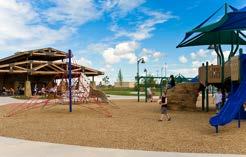
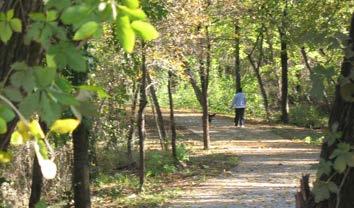
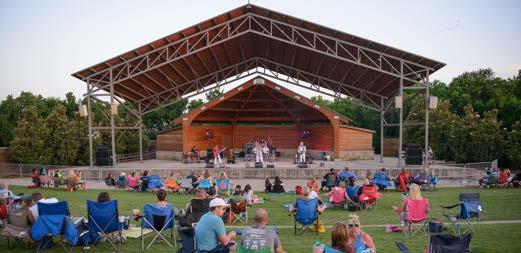



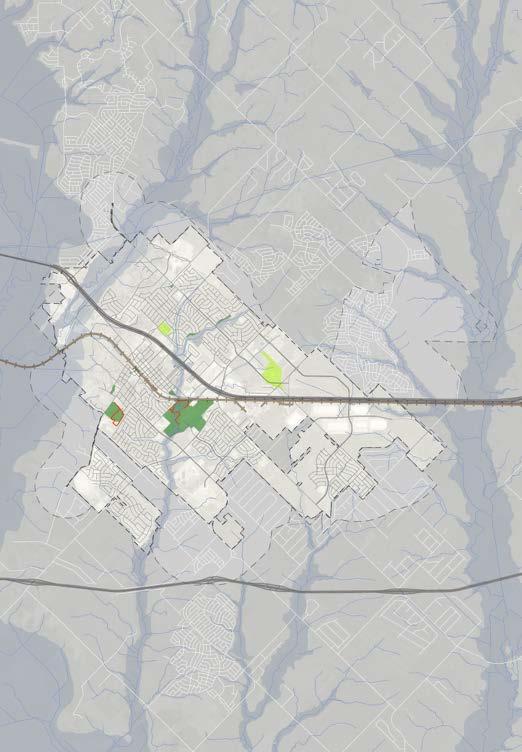


MINI/POCKET PARKS
Forney has three parks that are classified as Mini/Pocket Parks. They have been placed in the Mini/Pocket Park classification because the park size, location, and amenities offered. All three parks are in the downtown area with some seating.
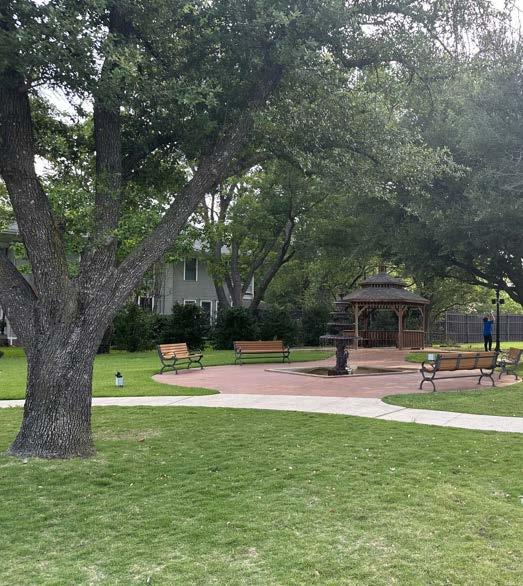

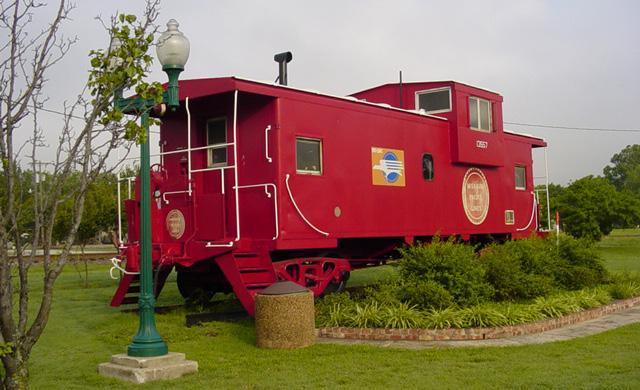
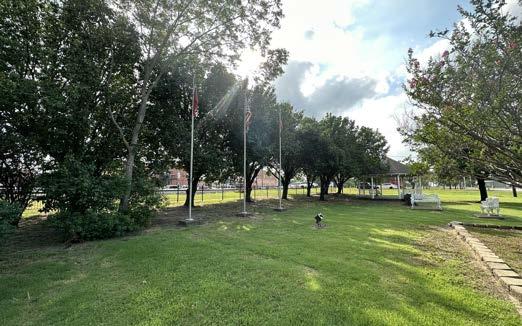

NEIGHBORHOOD PARKS
Forney has two parks that fit into the Neighborhood Parks classification. They have been placed in this classification because the park size and their proximity to their neighborhoods served and amenities offered.

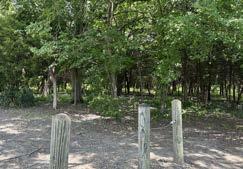
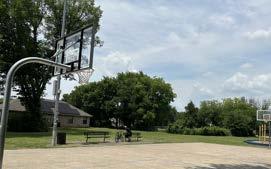
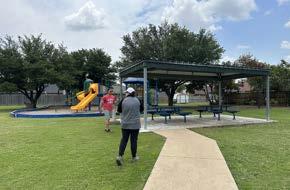
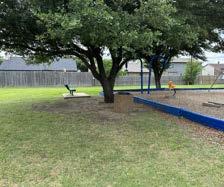


COMMUNITY PARKS
Forney has two parks that fit into the Community Parks classification They have been placed in this classification because the park size and their amenities. At the time of this report Forney Community Park is expanding its multipurpose fields and is undergoing construction.
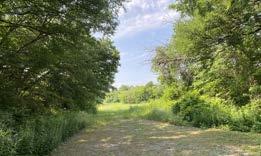
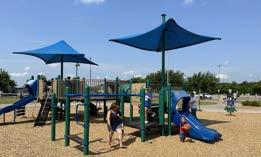
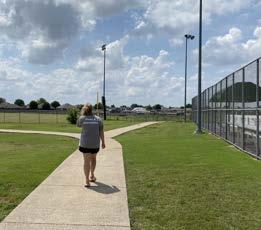
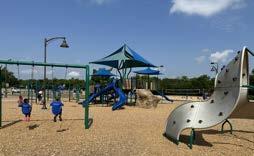
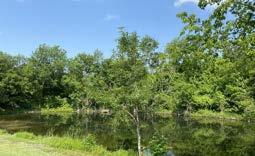
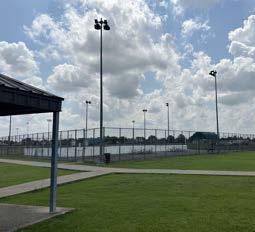

SPECIAL USE & LINEAR PARKS
Forney currently has one Special Use Park and two Linear Parks in these respective classifications. Forney Independent School District (FISD) Admin Football Field is currently the only park within the Special Use classification. Its amenities offered are why it is considered a Special Use Park. Parkland that will move to Special Use will be the downtown park that has not yet been developed and is currently in the Undeveloped Parkland classification.
The two Linear Parks are Mustang Creek Park and Park Trails Greenspace. These two parks are along the creek riparian corridor and partially protecting the area from further development. Moving forward these two parks will provide limited amenities beyond seating and trails due to the nature of Linear Parks.

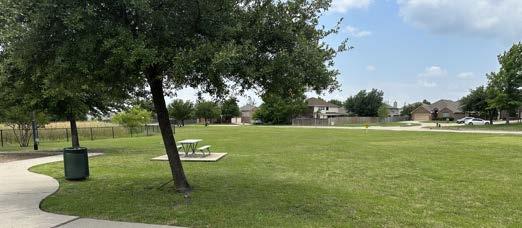

UNDEVELOPED AREAS
Forney currently has four properties that are in the Undeveloped Parkland category:
| McKeller Parkland
| Northside Park
| Pinson Farms Heritage Park
| The Economic Development (EDC) Downtown Park
McKeller, Northside, and Pinson Farms Heritage, and Downtown Park are all vacant and undeveloped. McKeller is a small pocket-sized lot that is considered a drainage area and located within a close to downtown neighborhood. Northside and Pinson Farms parklands are both located north of the train tracks and highway 80. When developed, these two parks would provide more access to greenspace and parkland for the north side of Forney.
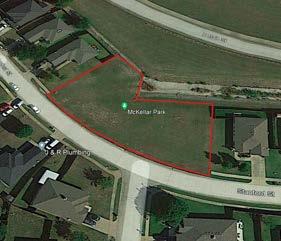
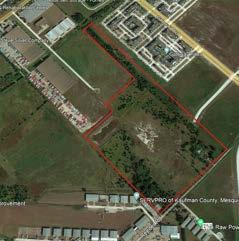
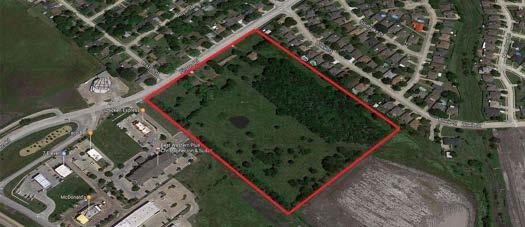
Existing Trails

TRAILS & CONNECTIVITY
Metrics for park facilities are more organized and prevalent than for public trails. The NRPA does report the median mile of trails for the population group of 20,000-49,999 (in 2023) is 8.0 which is well above the existing trails within Forney (3-miles).
The existing trails in Forney are within Mulberry Park and Forney Community Park. There are future connections which provide opportunities to tie into the surrounding neighborhood. Trails in Forney are currently lacking. This was also evident in the responses in the community survey as most survey participants had a desire to better connect to Forney Community Park as well as offering access to downtown and other key locations within the City.
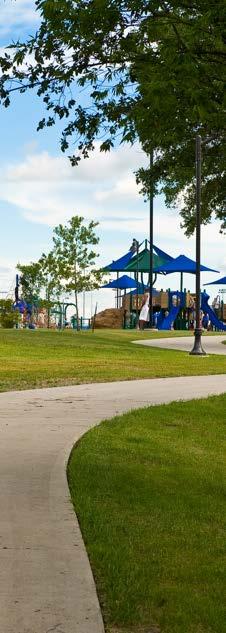
EXISTING FORNEY TRAILS
FIGURE 6
Community Assets & Programs

ADDITIONAL COMMUNITY ASSETS
For the purposes of this Master Plan, it is important to notate and document other recreational assets that are available to residents and visitors. These other resources are also considered when determining where the City should prioritize its resources when looking to enhance the City-owned system. These other resources are through non-profit organizations and private operations.
NON-PROFIT FACILITIES
A very common partnership as it pertains to recreation and sports is between the local government and the independent school district (ISD). It should be noted that currently residents of Forney do not have full access to all the amenities offered within Forney ISD.
The City of Forney is in the unique position that it contains Forney ISD which serves the Cities of Forney and Talty, a small portion of Mesquite, and other unincorporated areas in Kaufman Count; in other
words, the ISD is larger than the City of Forney. There are currently twelve campuses located in the Forney City Limits and three additional campuses within the extraterritorial jurisdiction (ETJ).
All offer recreational amenities with the elementary schools offering playscapes and sports courts and the middle high school offering various sport courts and fields. A unique facility located on the northwest side of Forney is Opportunity Central (The OC). This multipurpose campus aims to serve career development, access to higher education and community engagement opportunities. This facility has just completed construction as of Spring 2024 and is now fully open.
REGIONAL RECREATION
Lake Ray Hubbard is located approximately 13 miles north of Forney. The lake is used for fishing, skiing, relaxing and recreational boating.

RECREATIONAL EVENTS & PROGRAMS EVENTS
Throughout the year 2023 in Forney, Texas, a diverse array of events and celebrations filled the city’s calendar, offering something for everyone. From civic occasions like the commemoration of Martin Luther King Jr. Day to cultural festivities such as the Texas Independence Day Concert and the Cinco de Mayo Celebration with live music and delicious food, the city buzzed with activity.
Families enjoyed outdoor movie nights at the Spellman Amphitheater, including screenings of beloved films like Encanto and 101 Dalmatians. Special occasions like Memorial Day 5K runs and Founders’ Day Concerts brought the community together in celebration and
remembrance. Meanwhile, the Forney Animal Shelter hosted fall story times and festive events like Woof-OWeen and Trail of Treats, offering opportunities for furry friends to join in the fun. As the year drew to a close, the city sparkled with holiday cheer, from the Christmas on Main festivities to workshops like Charcuterie 101 and family-friendly events like the Flashlight Candy Cane Hunt. The year ended with a grand New Year’s Eve Balldrop, ringing in the new year with excitement and anticipation for the year ahead.
PROGRAMS
Along with diverse events and celebrations, Forney provides many sports fields, courts, and park spaces to
play organized sports leagues. The city also manages and operates youth and adult sports leagues which are currently offered in the Fall and the Spring:
Youth Sports
Boys Youth Baseball
6U (ages 5 and 6)
8U (ages 7 and 8)
9U and 10U (ages 9 and 10)
11U and 12U (ages 11 and 12)
13U and 14U (ages 13 and 14)
Co-Ed T-Ball
3/4U (ages 3 and 4)
5/6U (ages 5 and 6)
Girls Youth Softball
6U (ages 5 and 6)
8U (ages 7 and 8)
10U and 12U (ages 9 and 12)
14U (ages 12-14)
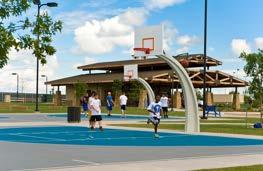
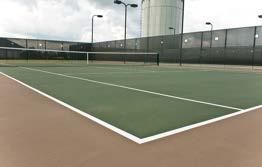

Adult Sports
Soccer
Co-ed (Males 30+ and Females 25+)
Cornhole (16+)
Sand Volleyball (16+)
Softball
Co-ed (16+)
Leagues that are not offered through the city are organized by local sports authorities. The following sports opportunities are available:
| Youth Soccer (Forney Soccer Association – FSA) –Fall and Spring
| Youth Football (Forney Youth Football League – FYFL and Red Raiders) - Fall Only
| Youth Flag Football (Neighborhood Sports) – Fall Only
| Youth Cheerleading (Forney Youth Football League – FYFL) – Fall Only Overall, the City has expanded its offerings since 2014 (the previous Master Plan) in recreational events as well as sports programming.
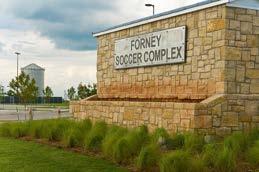
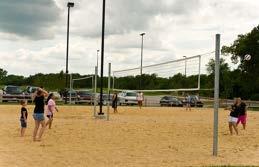
3.0
Needs Assessment
There is not a single set of standards in parks and recreation that could possibly encompass the uniqueness found in every community across the country. Communities vary greatly by size, needs, and desires...

NEEDS ASSESSMENT
Needs Assessment in this plan combines different approaches used in determining parks and recreation needs: standard-based, demand-based, and conditions-based.
The first section compares the facilities observed in the Existing Facility Inventory with annual national metrics, as published by the National Recreation and Park Association (NRPA). A peer city comparison was also examined. Forney contains HOA-owned facilities but it should be documented that NRPA only considers publicly owned parks and does not consider HOA-owned facilities as part of the park system.
The second section analyzes the community interest and demand for specific facility types extracted from the community input during this planning process. The NRPA acknowledges that communities are different and therefore, the needs are going to be different. This section reflects the City of Forney residents’ needs and wants.
The conditions-based approach is considering the quality and offering of current facilities but also combining the prior two assessment methods to determine amenities that should be added, renovated, or redeveloped to enhance the park system in Forney.
3.1 Understanding Needs Assessments

UNDERSTANDING NEEDS
The purpose of this master plan is to analyze both current and projected population figures. Its goal is to gauge potential future property acquisitions and potential collaborations, ensuring optimal advantages for the City of Forney and its residents. A robust parks and trails infrastructure can bolster the city’s economic growth and overall well-being. This section delves into various factors determining fair access and availability to parks, trails, and recreational amenities.
LAND AREA
Needs assessment can be looked at through park acreage relative to population. This is determined through the current population and the projected estimates. This gives a very generalized benchmark to strive for because it is important to establish standards and metrics based on unique local features such as user characteristics and preferences, demographics, regional climate, and other considerations.
POPULATION CONSIDERATIONS
The introduction told us that Forney’s population in 2023 was estimated with a low of 26,712 (numbers from the Comp Plan) and a high of 30,368 (consultant linear estimate). Estimates in the plan indicate that Forney’s population will steadily rise predicting 44,411 (consultant linear projection) on the higher end and 37,568 (Comp Plan projection) projected on the lower end for the year 2033. For the purposes of this report, the average of the two projections is used which is 28,540 for the 2023 population estimate and 40,990 for 2033.
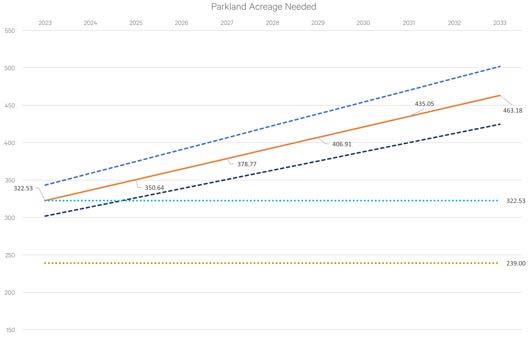


3.2 Standards-based Assessment

The 2023 Agency Performance Review metrics summary was reviewed and compared to Forney in the same table. The median population was used from the summary. The metrics included in the chart are the number of park acres per 1,000 residents and the number of residents served per individual park. Forney currently has 14 parks with four of these classified as undeveloped. These figures are compared to the 2023 median Forney population estimates and the 2033 projections. This snapshot provides one metric comparison of the future need for parkland and/or number of parks.
Quantity of land area metrics are typically measured in terms of acres of land dedicated for parks and recreational use per unit of population. NRPA’s median metric for municipalities with a population of 20,000-49,999 is 11.3 acres per 1,000 residents. In 2023, Forney has an estimated 11.3 acres of parkland per 1,000 residents which means presently, Forney is meeting this national metric. With the population increasing to a projected 40,990 (median estimate) in 2033 Forney will be well below the NRPA metric within the 20,000-49,999-population grouping, 7.87 acres of parkland per 1000 residents, if the City does not build/acquire any more parkland.
The second NRPA metric in this chart is the number of residents served by one park. The NRPA median number for 2023 for the same population category was 2,014. One park in Forney serves 2,039 people in 2023 and, again if parkland does not change, 2,928 residents in 2033.
PEER CITIES METRICS
Another consideration was comparing peer cities using the same metrics. Peer cities were considered based off a pre-existing list utilized by Forney when comparing population, parks budget and demographics. Of those cities, four agency park metrics were in the NRPA voluntarily supplied database.
2023 NRPA Metric Comparisons
FIGURE 7

In comparing the peer cities, the average across the cities, excluding Forney, is 15.2 acres of parkland per 1,000 residents. The highest acreage of 20.5acres is in the City of Cleburne. The lowest was Sachse with an 10.5 acreage per 1,000 residents. Forney is right at the average (11.3) the second lowest out of the five cities.
Peer City Comparison of Parkland/Resident
PEER CITY COMPARISON OF PARKLAND/RESIDENT
The average number of residents across the peer cities is 1,697. Again, this number excludes the City of Forney. Forney has the second highest number with 2,039 people per park. The total number of parks in Forney is 14 and four of those are parks are considered undeveloped parkland.
Lastly, a comparison of national peers (population wise) was run based on population projections for Forney from 2023-2033 to see how much parkland would be needed to accommodate a fast-growing community. Notable data shows Forney currently meeting the demands if the undeveloped parkland is included in the calculations. However, demand is not met starting in 2024/25 and population would quickly out-pace the current parkland acreage.
LOCATION, LOCATION, LOCATION
It is important to understand where parks within a system are located. It is an essential step in determining how well those parks are servicing existing and future park needs for the community. In an ideal situation, park sites would be distributed strategically so they are accessible, in a variety of ways, to all populated areas. This section locates and evaluates Forney’s parks facilities’ locations.
PARK SERVICE AREAS
Traditionally, the service area evaluation involves drawing a service area buffer of varying sizes around each park type. This is meant to symbolize a certain increment of a mile radius out from the center of the park site. Typically, these radii represent a ¼ mile, ½ mile, and full mile. If an area fell within this radius, this would approximate how far away it was from the park and if this park serviced this area.
This plan’s process in determining service areas, just like its focus, is unique. There is still a buffer area measuring the respective distances - 5-minute (1/4-mile walk), 10-minute (1/2-mile walk), or 15-minute (a faster walked mile), 1 mile, 2 mile and 5 mile (all drive times) - from the park site however, this buffer area is not in a circle, it is along the transportation network – roads, sidewalks, and trails. This analysis of determining service area provides a more accurate and relatable distance, with a realistic way to access the site (walking, biking, or using a motorized vehicle).
Forney, TX Cleburne Coppell Rockwall Sachse
Forney, TX Cleburne Coppell Rockwall Sachse
FIGURE 8

SERVICE AREA EVALUATION
This first map is an analysis of the 5-, 10-, and 15-minute walk. A large portion of the developed areas in Forney are provided coverage.



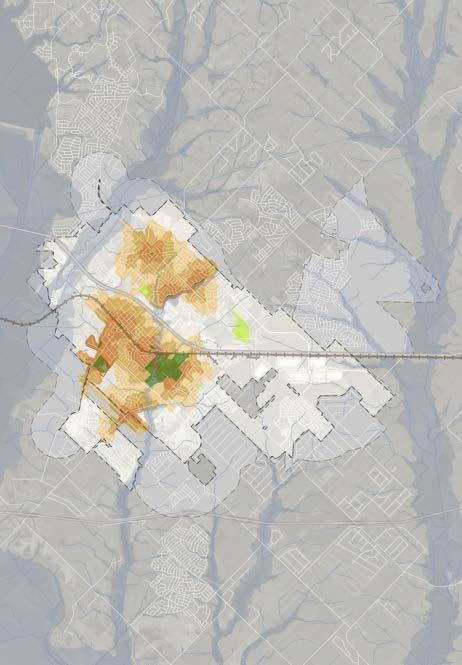
LAWSON
KLEBERG SAND BRANCH
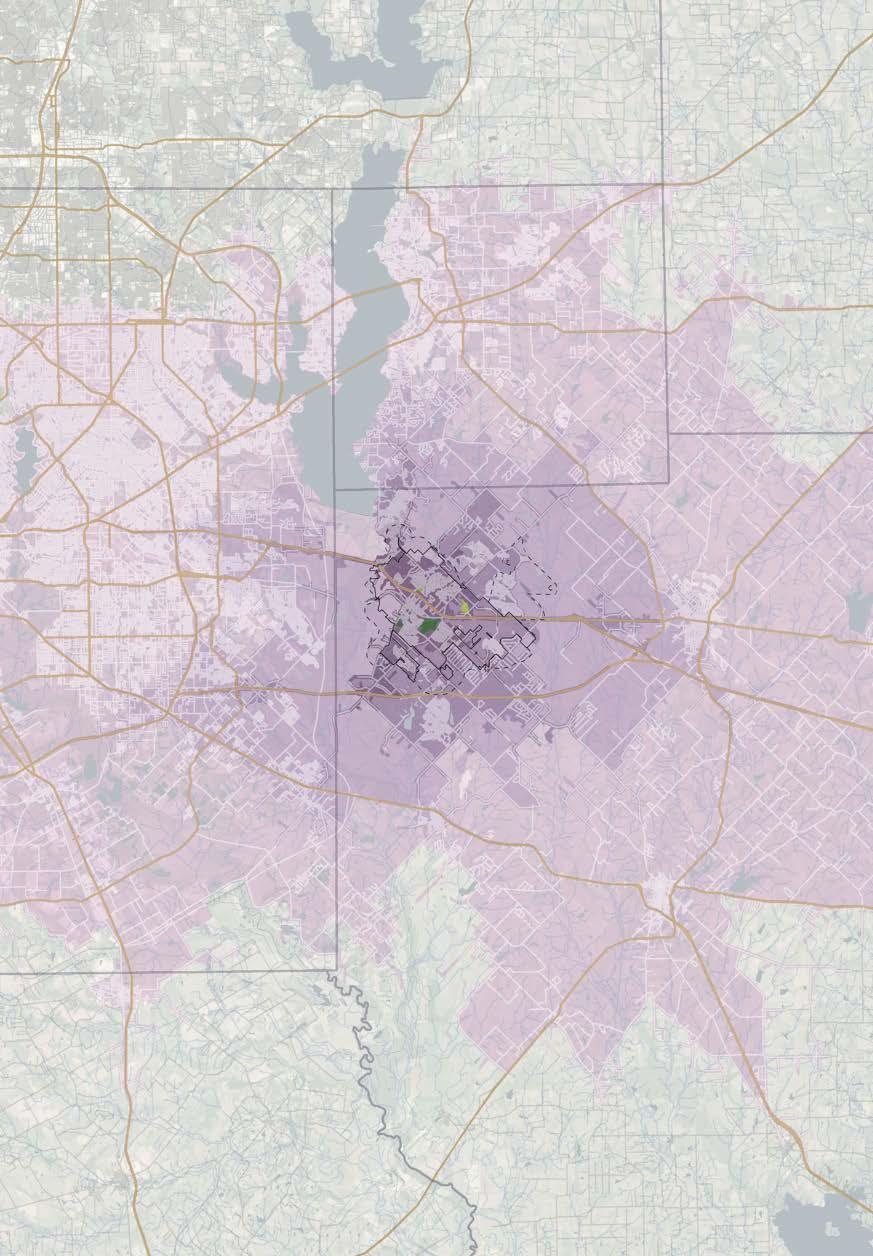


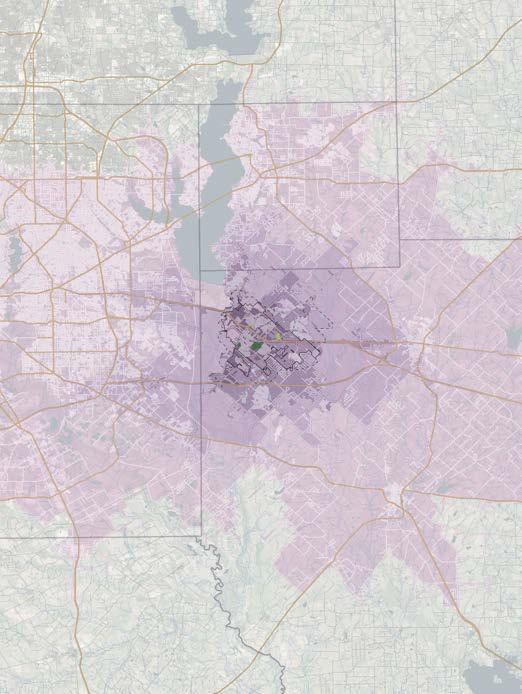

QUANTITY OF FACILITIES
Land area is a critical component to recreation planning. The other factor that is just as important is developing this land with the correct mix of facilities and amenities. This is unique to each community and where again, the demographics of the City are integral to the process.
NRPA FACILITY COMPARISON METRICS
TABLE 3
The tables here display the median number of people served by specific park facility types as reported in the 2023 summary by the NRPA. The facility type is broken into two categories – outdoor and indoor. The population used from NRPA is the 20,000-49,999-population range due to Forney projected in this range in 2023. It also establishes the potential number of needed based on the 2033 (average) population projection. A reminder that the NRPA Performance Review Summary is based on national metrics and the focus should be on the demands and needs of the residents of Forney. This table acts as a starting discussion point for analyzing current and projected needs.
The following observations were gleaned when comparing the existing facilities with the
and peer metrics:
|
|
| Forney does not have a community or recreation center available to the public.
| The 2033 projected needs would require a significant amount of development to occur within a relatively short timeframe.
| Notable amenities missing include a community or recreation center, an aquatics facility, and an adequate number of sports courts and fields.
TABLE 4

COMMUNITY INPUT – NEEDS & WANTS ASSESSMENT
This segment of the needs assessment integrates the viewpoints and sentiments of Forney residents who utilize the community’s local parks, trails, and recreational amenities. While these individuals may not have frequented every facility, they possess preferences, requirements, and standards for the quality of services offered to both residents and visitors.
THE IMPORTANCE OF PUBLIC INPUT
One of the fundamental roles of government is safeguarding the health, safety, and overall welfare of the populace. Park facilities, trails, and similar amenities exemplify these core responsibilities. These outdoor spaces not only promote physical fitness but also offer opportunities for residents of all ages to engage in recreational activities outdoors. Furthermore, access to public parks and natural environments has a positive impact on mental wellbeing. Welfare extends beyond mere health and safety, encompassing the overall quality of life and attractiveness of a community. Local parks, trails, and recreational facilities can significantly contribute to a city’s economic prosperity, often serving as key components of its “quality of life” infrastructure that attracts tourists and visitors.
PUBLIC INPUT METHOD
Throughout this planning process, the public was engaged through a variety of mechanisms including:
| Park Advisory Board Meetings – July 12, 2023, October 18, 2023, November 15, 2023, March 20, 2024
| Public Meetings – September 30, 2023 & January 25, 2024
| Online Survey – September 30-October 14, 2023
| City Council Presentations – June 30, 2023 & April 2, 2024
Appendix B includes all public survey responses and meeting feedback from the Parks Board.
PARK ADVISORY BOARD MEETINGS
The Parks Advisory Board was an integral pillar of community engagement. They represent different communities from within Forney. Parkhill presented to and updated the Parks Advisory on the Parks & Trails Master Plan process. The presentations involved a review of all efforts to date. Parkhill explained how the
master plan process was designed to adhere to the Texas Parks and Wildlife Department’s plan criteria. The group was asked for thoughts and priorities from the current goals from the Future Forney Comprehensive Plan. Part Three | Guiding Principles, outlined five guiding principles reflective of the community values. Those principles and the goals and strategies associated were discussed along with interactive responses through slido.com (see Appendix B.)
PUBLIC INPUT MEETING
On September 30th, Parkhill hosted two community input meetings: one at Forney Community Park in the morning during soccer games and another in the evening at the annual Brews on Bois d’Arc event. Both sessions were a casual, “Come & Go” style where consultants and staff explained the process of the master plan (complete with a gameboard), asked for input and answered any questions they had. In the graphics provided, there was a QR code which took participants to an online survey which was also later shared on the City’s social media for residents.
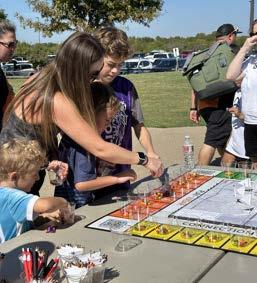

ONLINE SURVEY
The online survey was open from September 30-October 14, 2023. The survey consisted of 36 questions and received 400 individual responses (see Appendix B). The results included in this section are those most relevant to the resource needs for Forney’s parks, trails, and recreation system.
BEYOND FORNEY
Forney’s recreational situation is unique in that there are multiple surrounding communities that are unincorporated, within other city limits, or are within the Independent School District who utilize the Forney Parks System. The survey did include responses from those individuals however, this was not the majority of responses collected.

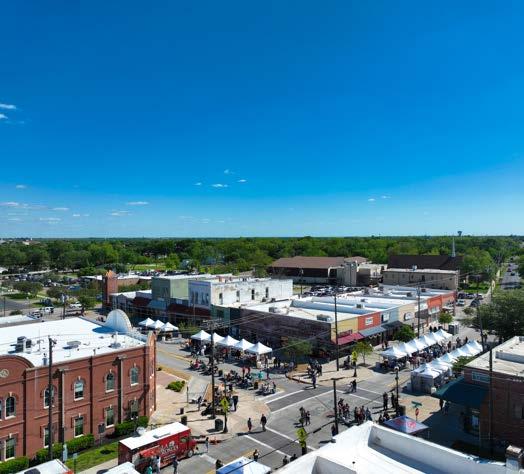
HOUSEHOLD
Average number of people in a household
Live in Forney City limits
SURVEY RESPONSES
SURVEY DEMOGRAPHICS
SURVEY DEMOGRAPHICS
72% 11% 17%
AGES IN HOUSEHOLD
COMMUNITY INPUT
Live in the Extraterritorial Jurisdiction (ETJ)
Live in the Outer Municipalities
PERCEPTION OF FACILITIES

PERCEPTION OF FACILITIES


Is the most visited park in a given month with 83% of the respondents inside the city limits and ETJ.
62% Want to see more of a combination of active and passive recreation
PERCEPTION OF FACILITIES

FORNEY COMMUNITY PARK 7/10
Average rating of the existing facilities and level of maintenance

COMMUNITY OBSERVATIONS
The most popular sports for households with children are:
Community themes of CONSERVATION, & CONNECTION
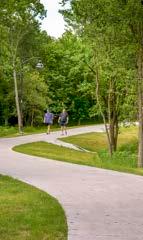
COMMUNITY OBSERVATIONS
COMMUNITY OBSERVATIONS
Having a Recreation Center is the second highest priority (after Trails) when thinking about Connection Soccer has the highest participation of any sport in Forney by adults and children
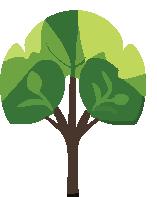






People would like to see more proper lighting around Parks and Trails

would like to see more shade in the Park System
Having more trees in the Parks System















The top 4 play features that people surveyed wanted to see more in Forney
•Playground equipment •Recreational programs •Water play •Adventure play















Expanding opportunities for the arts and cultural activities throughout Forney was of interest to the community It is important for the community to have a variety of options when it comes to physical health
The majority of people want to see more trails












ASSESSMENT OF PARK CONDITIONS
The condition of the existing parks, trails and recreation facilities assist in understanding the perception of the quality of a city’s overall system. Appearance and maintenance of Forney’s park and trails contribute to the community’s image and perceived livability. Forney should continue to provide diligent care of its grounds and improvements.
A condition assessment of the Forney’s parks was performed concurrently with the existing facility inventory. The scoring categories are listed here:
| Turf
| Plantings, trees, landscape beds, natural areas
| Parking
| Sidewalks, trails, and pathways
| Sport Courts and equipment
| Accessibility
| Amenities
| Buildings, shelters, and pavilions
| Sports fields and equipment
| Signage
| Fencing and
| Lighting
The criteria assessment and associated evaluation is in Appendix C. A summary of the findings in each category can be found here.
OVERALL CONDITIONS
Each park category received a score ranging from zero to four – zero represented the features were in the worst condition and would warrant replacement, rehabilitation, or reconstruction and a four would be great condition with no need for repair. The scoring of one, two, or three represent the varying condition levels. No score was given in an instance where features did not exist in specific parks. The score of 0 was given to parks that did not have any natural areas or a 1 if there were natural areas present. The composite score indicates the park’s overall condition and, in turn, provides a means to compare each facility’s state to another within the whole city. Using this score chart, priorities can be determined both in maintenance as well as park replacement, rehabilitation, or reconstruction. In short, the higher the overall score, the better condition.
Overall, the weighted scores for Forney owned facilities ranges from 1 (Northside Park and Pinson Farms Heritage Park) to 2.82 (Forney Community Park). Undeveloped land is included in this facility assessment and primarily was scored on whether the land has natural features and the ease of access to the park. Three of the four undeveloped parkland have natural features. This is important to factor in when thinking about development of the parkland and the potential preservation of existing natural features. The undeveloped parkland rank from 1.0 (Northside Park and Pinson Farms Heritage Park) to 2.0 (Economic Development Corporation [EDC] Downtown Park). Developed parks rank from 1.27 (Hamblen Park) to 2.82 (Forney Community Park).
TURF
The turf in the City-owned or maintained parks is in moderate condition overall. Forney Community Park has the most turf due to its size and the maintenance of the turf within the park being in moderate condition. Alternatively, Mulberry is the second largest developed park, and its turf conditions are poor with areas that were worn down, overtaken with weeds, or extremely patchy.
PLANTINGS, TREES, LANDSCAPE BEDS & NATURAL AREAS
Overall, the planted trees within the parks in Forney are in good condition. Most of the trees planted are located along the perimeter of the facilities and therefore will not offer shade in heavily trafficked areas.
Of the 14 parks within the City, only five possess landscaped beds and are primarily in moderate to poor condition. Forney Community Park’s landscaped beds were installed in initial construction however they were not maintained and are nonexistent at present day. Bell Park has the most formally landscaped beds and while the plantings are alive, they are needing replacements. Eight out of the 14 parks have natural areas with Forney Community Park having the largest treed area along Mustang Creek.
PARKING
Four of the parks in Forney have off-street parking, and they are all in good to poor condition with the
lowest score being a 1.0. at Mulberry Park. Bell Park has on-street parking with accessible spaces located in the downtown area.
SIDEWALKS, TRAILS, & PATHWAYS
Only three of Forney’s parks have relatively good sidewalks, trails, and pathways. Forney Community Park, Park Trails Greenspace, and Bell Park scored 3.0s due to minor maintenance required. Caboose, Hamblen, Mulberry, and Heritage Hill rate at a poor condition due to concrete age as well as accessibility.
ACCESSIBILITY
All of Forney’s developed parks are considered moderate to good accessibility as most are relatively easy to locate and access. Despite the EDC Downtown Park being undeveloped, it is (and will be, once developed) very easily located and accessed by any means with its location being in the downtown area.
The accessibility within the developed parks ranges from good to very poor. Forney Community Park, Park Trails Greenspace, and Mustang Creek have the highest ranked accessibility. Hamblen Park was rated very poor to no accessibility as there are currently no accessible amenities, parking, or facilities.
PLAYGROUND EQUIPMENT & PARK AMENITIES
Eight out of ten of the developed parks have amenities offered with most considered moderate to good condition. Hamblen Park is the only park with amenities considered in poor condition due to being aged out.
There are currently five parks offering playground equipment in Forney. All surfacing on the playgrounds is wood fiber chips and most surfacing levels were low at the time of park inventory.
BUILDINGS, SHELTERS, & PAVILIONS
Eight out of the ten developed parks in Forney contain either buildings or some sort of shade structure. All are in good to moderate condition with Forney Community Park and Bell Park having the best maintained out of the eight.
SPORT COURTS
Forney Community Park and Mulberry are the only two parks that have sports courts. Forney Community Park has Volleyball and Tennis and Mulberry has asphalt

tennis courts that have been repurposed into a roller hockey rink that is currently not being utilized.
PLAYING FIELDS & EQUIPMENT
Forney Community Park and Mulberry Park are the only two parks in Forney that contain sports fields and equipment. Forney Community Park has softball, soccer, and multipurpose fields, which are currently under construction. These fields are in good condition and are well maintained throughout the seasons. Mulberry Park has softball fields and are in poor condition yet still very highly used.
SIGNAGE
Signage at Forney Community Park and Bell Park are in good condition. Mulberry Park is the only park requiring immediate replacement for signage.
FENCING & LIGHTING
The parks in Forney which have any fencing are on sports fields or courts and they are in good to moderate condition. There are no parks in Forney with continuous perimeter fencing.
There is currently lighting in ten of the developed parks in Forney. Of those ten highlighted parks, Mustang Creek, Hamblen, and Caboose Park are in poor condition primarily due to the lighting being older and outdated and replacement is a priority for these parks..
An effective park system should aim to ensure fair access to parks for all community members.
Systemwide Recommendations
Systemwide Park Recommendations

SYSTEMWIDE PARK RECOMMENDATIONS
An effective park system should aim to ensure fair access to parks for all community members. Parks offer health, economic, and safety advantages that reach throughout a neighborhood. Research conducted by organizations like the Trust for Public Land (TPL) and the National Recreation and Park Association (NRPA) has shown that parks, especially when linked by walking and biking paths, greatly enhance the quality of life in a community.
In addition to physical proximity to parks, the accessibility of parks can be evaluated based on the range of programs and amenities they offer. Parks can cater to both passive and active recreational activities, accommodating various preferences within a community.
The Forney Park System can improve accessibility and variety by incorporating various amenities, promoting its brand, and enhancing its overall brand awareness among residents and visitors..
ParkServe Map Export
The City should consider strategic enhancements to modernize park amenities, focusing on introducing new facilities and programs that better serve residents’ needs and preferences.
ParkServe Map Export
GAPS IN PARK SERVICE
There are spaces within the City that require prioritized attention for future park development due to restricted park access. These highlighted zones are categorized into two groups: those anticipated for future development and expansion, and those already developed where residents require increased accessibility to park facilities and amenities.
Providing access to facilities as well as planning for access to the future can be accomplished simultaneously. Coordination with other departments as well as developers is key to accomplishing this vision. Access can also be accomplished by providing new amenities and programs in unprogrammed parkland.
There are areas that fall outside of a 15-min walking radius of an existing park in Forney today. These areas indicate the highest demand for more park spaces and amenities within the city. Most of these areas are on the east side of the city with some smaller gaps being in the southern portion as well.



World Hillshade: Esri, NASA, NGA, USGS, FEMA
4.2
Systemwide Trail Recommendations
POTENTIAL TRAIL NETWORK
Trails were mentioned frequently in the public engagement efforts with both residents and the Parks Advisory Board. Participants desired better connectivity and the number one destination to connect to is Community Park. This plan considered this community desire when determining priority areas. The priority areas are where the city should focus its immediate



efforts on when considering land acquisitions and future trail development. Much of the proposed priority trails are along Mustang Creek. This serves a dual purpose – recreational as well as preservation. This plan also looked outward to include the immediate area outside of Forney as well as and included the Veloweb, the regional trail network that aims to connect all cities in the DallasFort Worth region.

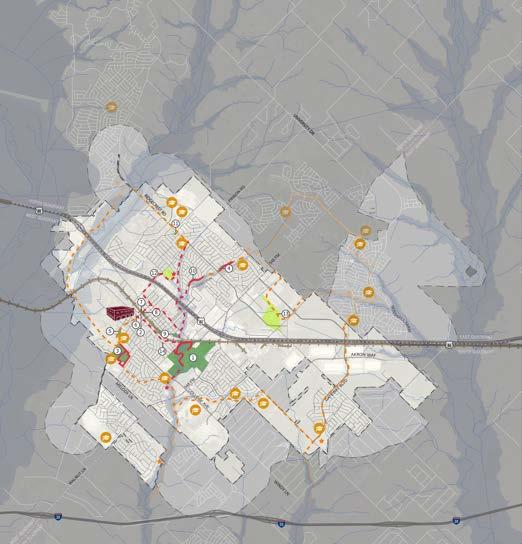
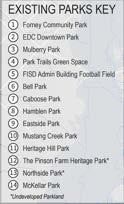
FIGURE
FUTURE TRAILS & CITY-WIDE CONNECTIVITY
As stated in Section Two of this report, the existing trails within Forney were totaling approximately 3-miles within the city. Both trails are in developed parks and do not provide access or connectivity to other areas in Forney.
With future trail development in mind, Forney would like to categorize its trails into three categories: roadside, off-street, and Veloweb. The corresponding images demonstrates what a typical trail standard could be moving forward.
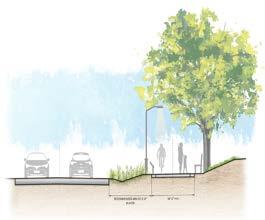
Trails
Roadside
TRAILS

Trails located adjacent to a roadway with an appropriate buffer distance from the vehicles. AASHTO recommends that roadside trails be at least 10’ wide to safely accommodate multiple types of users. Trail user safety at driveways and intersections is a very important consideration for roadside trails.
Trails
Trails located away from roadways either in a greenbelt, along a creek corridor, along a utility corridor, or within a park with a minimum width of 8'. The American Association of State Highway Transportation Officials (AASHTO) recommends that off-street trails are at least 10’ wide to safely accommodate multiple types of users.
Regional trails that connect multiple communities and are designated on the North Central Texas Council of Governments (NCTCOG) Regional Veloweb map. These trails are designated with a 12' width minimum.
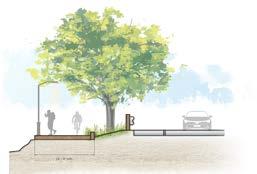
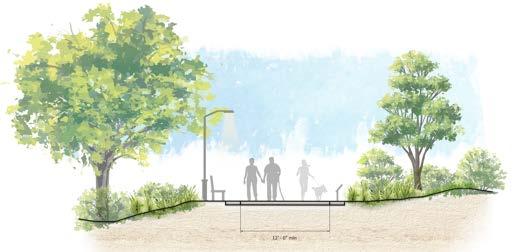
Off-Street
Veloweb
Trails
5.0
Callout
Summary
Statement
Actur labulissen diu visse ret, concultusque nocuppl. As viris? Fue cupiora nem am errae comanterit, publinam res lari plicio clus reo egit. Tam patquodiis, us inatus effre hora conlosti pubissicerum
Implementation & Funding Resources
Implementation Action Plan

VISION #1: BALANCED GROWTH
Goal BG-4: Establish an integrated system of parks, trails, and recreation facilities.
Initiate and update the 2014 Parks Master Plan
4.1A: Complete the overall Parks, Trails, and Open Space Master Plan
4.1B: Annually review goals in relation to projects and funding available
BG-4.2: Evaluate programming offerings and associated fees provided by the Parks and Recreation Department to ensure they meet the needs of residents and reflect true costs.
4.2A: Set annual goals for participation on existing programs and continue monitoring
O
Integrate more passive recreational opportunities into the parks system.
4.3A: Evaluate needed facilities for Heritage Hill Park
4.3B: Prioritize Trail and Trailhead projects and development
Design parks to meet the needs of Forney’s residents of all ages and abilities.
4.4A: Pursue location and plans for a new allinclusive park space
4.4B: Multipurpose field updates and pavilion (Forney Community Park)
BG-4.1:
BG-4.3:
BG-4.4:

4.4C: Update existing playgrounds and determine appropriate locations for poured-in-place (PIP) safety surfacing to enchance accessibility
4.4D: Review, update, and/or create Master Plans for each individual parks, specifically for the undeveloped parkland, and provide updated Master Plans for Northside Park, Community, and Mulberry Park
4.4E: Provide maintenance updates to Mulberry Park - fields, sod, and drainage
4.5A: Review and revise current Parkland Dedication and Fee Ordinance. Develop a process to review ordinances annually.
4.5B: Include Parks personnel on the Development Review to review plan submittals not only to meet technical requirements but also quality of life, design standards, and recreational needs
4.6A: Construct Community Park trail system to College Ave (FM 741)
4.6B: Construct priority trails based on the Feasibility Study
BG-4.5: Integrate parks and open space into new developments.
BG-4.6: Utilize green corridors and floodplains for trail corridors to connect residents with key areas within the city and the larger region.

VISION #2: CONNECTION
Goal CN-1: Further develop the network of sidewalks, trails, and bikeways that connect to key destinations such as parks, schools, areas of employment, and downtown.
CN-1.1: Expand sidewalk and trails network in and around Downtown and Mixed-use place types.
1.1A: As Downtown continues to grow, focus on connecting the area with other public gathering spaces (i.e. Community Park, Mulberry, etc)
CN-1.2: Incentivize trail segments as part of private development; prioritize development criteria (Network connectivity, Access to natural features, Access to parks, Length)
1.2A: Evaluate and revise existing Parkland Dedication Ordinance (update annually)
CN-1.3: Adopt an active transportation master plan for Forney to determine feasible locations for trails, sidewalks, on-street facilities, and connections to the greater region.
1.3A: Hire a consultant to create an active transportation master plan
CN-1.4: Create connected trail network.
1.4A: Develop a plan to incorporate the parks land the city already has to extend trail system
1.4B: Adopt trail typologies and standards
1.4C: Prioritize the priority trails designated in the 2023 Parks & Trails Master Plan with the intent to begin purchasing trail easements.

Goal CN-2: Work with partners to expand, improve, and maintain the transportation network to support current and future transportation needs of residents, businesses, and visitors.
2.1A: Initiate discussions with TxDOT on feasible trail crossing locations
2.1B: Continue coordination with TxDOT through Trail Feasibility Study
CN-2.1: Find suitable locations for a trail crossing US HWY 80 connecting North and South Forney
CN-2.2: Work with TxDOT, NCTCOG, and other partners to fund and construct trail crossing at US Hwy 80.
2.2A: Explore availabile funding opportunities to construct trail crossing
Goal CN-3: Build out Forney’s thoroughfare system in a context-sensitive manner to ensure community connectivity, safety, and access.
CN-3.2: Create design guidelines for context-sensitive rights-of-way design based on intended character of development and intended users of the roadway.
3.2A: Design a citywide plan to standardize city gateways, monuments, and medians to ensure a cohesive design for Forney
3.2B: Communicate and work with participating parties to ensure design standards are established and upheld
CN-3.3: Make strategic investments in crosstown connectivity by identifying alternative transportation connections across the city.
3.3A: Conduct a feasibility study on the priority areas of the Trails Master
3.3B: Purchase trail easements along priority areas of the Trails Master Plan

Goal CN-4: Explore innovative solutions to transportation challenges that improve connectivity, safety, and access.
CN-4.4: Adopt regulations which allow sidewalks and trails to be located within landscape buffers to increase distance between the sidewalk and travel lanes.
4.4A: Evaluate and/or revise existing ordinances to allow for design standards for pedestrian connectivity
VISION #3: COMMUNITY
Goal CM-1: Provide high-quality city facilities at a level of service meeting national standards of excellence to maintain the health, safety, and welfare of all residents.
CM-1.3: Invest in public institutions to meet diverse needs of residents. Public institutions may include library, recreation center, civic center/events center,
senior center, etc.
1.3A: Look at feasability of a combined library/ recreation center.
1.3B: Construct feasible public center in determined
1.3C: Start application process of Commission for Accreditation of Park and Recreation Agencies (CAPRA) accreditation.
1.3D: Develop a parks and trails maintenance management plan and track performance.
1.3E: Establish performance measures for Parks, Recreation, and Open Space and track on an annual basis.

CM-1.5: New public facilities should be designed to support the community, be accessible, and create opportunities for social engagement and activity.
1.5A: Reference Parks & Trails Master Plan biannually to determine priority areas and needed facilities for park development.
1.5B: Develop master plans / feasibility studies for priority areas and needed facilities for park development.
1.5C: Determine stakeholders and interest groups involved in specific park developments.
1.5D: Continue to develop relationship with Forney ISD to collaborate on Opportunity Central (OC) programming that would mutually benefit the Forney Community.
1.5E: Determine location and develop Sport Court Additions (Pickleball & Tennis).
1.5F: Update facilities and program to downtown Mini/Pocket Parks.
1.5G: Update Neighborhood Park Playgrounds in Heritage Hill and Mustang Creek.
Update Splash Pad in Community Park.
1.5I: Conduct feasibility study on Disc Golf Course to determine public need and location.
1.5J: Construct Northside Park (ensure Northside Park Master Plan is developed and approved prior to construction).

1.5K: Construct Forney Community Park Phase II (ensure Forney Community Park Master Plan is updated and approved prior to construction) Phase II = Baseball Complex, Trail System, and Recreation Center.
CM-2: Establish design standards and guidelines that support high quality development aligned with guiding principles of comprehensive plan.
Establish supplemental regulations and/or design standards for multi-family and mixed-use properties: Vehicular, pedestrian, bicycle connectivity, landscaping, green space, open space.
2.1A: Coordinate with Planning and Zoning Commission on development design standards and guidelines.
CM-2.3: Require cross-access between commercial developments to reduce traffic demand on arterial roads and enhance connections to residential areas through trails and sidewalks.
2.3A: Coordinate with Planning and Zoning Commission on development design standards and guidelines.
3.1A: Examine additional funding resources for cultural activities
3.1B: Coordinate with Economic Development Corporation to designate fees towards public art
3.1C: Explore a matching funds program for a public/ private partnership
Increase amount of public art installations in Forney.
3.2A: Look at areas where functional art can serve multiple purposes (Downtown and along trails)
CM-2.1:
Goal CM-3: Expand opportunities for arts and culture throughout Forney.
CM-3.1: (Re)dedicate funds for arts and culture activities.
CM-3.2:

3.2B: Examine development code requirements and park dedication ordinance in efforts to add a percentage or dollar amount for public art
3.2C: Explore the creation of a Public Art Master Plan
CM-3.4: Continue to provide events and activities for Forney's residents.
3.4A: Look at hosting new cultural events, such as Diwali, at Community Park (advertise to the Community)
Explore the creation of a position dedication to Arts & Culture.
3.6A: Coordinate with Forney Arts Council to establish dedicated position
VISION #4: OPPORTUNITY
1.1A: Create a Main Street Master Plan Trail Connection (between Downtown and Community Park)
1.1B: Create a phasing plan for Main Street Master Plan Connection implementation with costs

OP 1.7: Invest in signature downtown park or plaza within Downtown Forney.
1.7A: Create a Downtown Master Plan
OP-3: Leverage opportunities to increase economic impact of visitors to Forney.
Explore/establish sports tourism for Forney Parks and Recreation.
3.1A: Continue sports tournaments but look at other sports ventures that could have a fiscally positive impact.
VISION #5: COLLABORATION
CL-2: Utilize intergovernmental partnerships to enhance public services. CL-2.1: Establish regular conversations with neighboring municipalities to align projects and services related to transportation, services, and long-range planning.
2.1A: Maintain awareness of agreements and future regional plans within Kaufman County
Continue proactive collaboration and alignment between City of Forney and Forney
2.3A: Begin discussions on how EDC can provide funding to boost tax base through Parks, Trails, and Open Space initiatives.
Explore the opportunity to create interlocal agreements with Forney ISD to utilize school park facilites during non-school hours to improve access to parks for Forney's residents.
2.5A: Maintain and update interlocal agreements with Forney ISD

2.5B: Discuss with ISD Program Facilities and City Council on OC Programming
O
CL-2.6: Explore the creation of a Forney Park Development Corporation.
2.6A: Visit with peer or regional municipalities that have a PDC Policy M
Goal CL-3: Continue to support Forney's community organizations.
CL-3.1: Cultivate strong relationships with community organizations to support community initiatives.
3.1A: Stay involved and continue to interact with Chamber/Youth Groups/Community Orgs.
O
CL-3.3: Support efforts of the Spellman Museum and Forney Arts Council through funding and collaboration to increase resident access to arts and culture.
3.3A: Continue supporting the arts through events and the downtown market
- Ongoing
Operation of
- To be determined by future
- $100K - $500K
- More than $500K
O
Funding Programs & Resources
FUNDING PROGRAMS & RESOURCES
The final portion of this plan discusses different funding sources available to the City of Forney that may be relevant to implementing this master plan. The following is not exhaustive but does highlight the most pertinent opportunities.
Federal Funding Sources CONSERVATION TECHNICAL ASSISTANCE PROGRAM
Assists entities in planning and implementing conservation systems to reduce erosion, improve soil and water quality, improve and conserve wetlands, enhance fish and wildlife habitat, improve air quality, improve pasture and range condition, reduce flooding, and improve woodlands.
https://www.nrcs.usda.gov/wps/portal/nrcs/main/ national/programs/technical/
NATIONAL PARK SERVICE (NPS) PROGRAMS
Include the Land and Water Conservation Fund (LWCF) and Urban Park and Recreation Recovery Act (UPARR), which provides funds for parks and recreation. Congress appropriates both funds. Typically, the funding sources have supported traditional parks rather than linear systems. From 1965 to 2014, LWCF has provided more than $4.1 billion as grants to state and local governments.
THE LAND AND WATER CONSERVATION FUND
The Land and Water Conservation Fund (LWCF) was created by Congress in 1964 to preserve and safeguard natural areas, water resources, cultural heritage and to provide recreation opportunities to the American people. LCWF provides funding for:
| Land acquisition for federal land managing agencies
| Matching grants to state, local, and tribal governments to create and expand parks, develop recreation facilities and further local recreation plans.
For more information about LWCF, their stakeholders and advocacy work, go here:
https://lwcfcoalition.org/

RECREATIONAL TRAILS PROGRAM
This program provides funds to entities to develop and maintain trails for both motorized and non-motorized users. Funds are administered through the states.
https://recreationaltrailsinfo.org/
REBUILDING AMERICAN INFRASTRUCTURE WITH SUSTAINABILITY AND EQUITY (RAISE ) PROGRAM GRANTS
This program assists urban and rural communities move forward to modernize roads, bridges, transit, rail, ports and intermodal transportation and its systems to provide safer, more accessible, more affordable, and more sustainable. Grant funds are for planning and capital investments. Funding is split 50/50 for both rural areas and urban areas. Fiscal Year 2022 allocated more than $2.2 billion to projects and gets an additional $7.5 billion over fives years. Projects are evaluated for safety, environmental sustainability, quality of life, economic competitiveness and opportunity, partnership and collaboration, innovation, state of good repair, mobility and community connectivity.
| Largest grant awarded in 2022 - $25 million | No more than $341.25 million can be awarded to a single state in FY 2022 round of funding
More information about the RAISE Grants can be found here:
https://www.transportation.gov/RAISEgrants
STATE FUNDING SERVICES
TEXAS PARKS AND WILDLIFE
The Texas Parks and Wildlife Department (TPWD) has several grant programs that have assisted hundreds of communities across Texas. TPWD administers grants for projects in various categories based on community population size and scope. All grant-assisted sites must be dedicated as parkland in perpetuity, be maintained, and open to the public. Program funding comes from a portion of the state sales tax on sporting goods, supplemented by federal offshore gas royalties through the Land and Water Conservation Fund. The program provides 50% matching grants on a reimbursement basis. The application process is handled entirely online (search for “Texas Rec Grants Online”). The application due date is in November of each year. Forney is eligible for the following grants:
| Local Parks Non-Urban Outdoor Recreation (Grant Ceiling $750,000)
| Local Parks Non-Urban Indoor Recreation (Grant Ceiling $1M)
RECREATION TRAILS FUND
TPWD also administers funding for constructing and improving both motorized and non-motorized recreational trail projects, developing trailheads and trailside facilities, and acquiring trail corridors. Funding is under the approval of the Federal Highway Administration (FHWA). These reimbursable grants can be up to 80% of project cost. The application due date is in February of each year.
| Maximum award for non-motorized trails - $300,000
| Maximum award for motorized trails - $400,000
URBAN AGRICULTURE RESILIENCE PROGRAM
This relatively new program seeks to promote public garden participation in community collaborations that combine food growing and education while addressing food security challenges. The application due date is in March of each year.
| Amounts awarded range from: $5,000-$20,000

NATIONAL ENDOWMENT FOR THE ARTS (OUR TOWN)
National Endowment for the Arts (NEA) is an independent federal agency established as the largest funder of the arts and arts education in communities around the nation. NEA’s primary activities include grantmaking to nonprofit arts organizations, public arts agencies and organizations, higher education facilities, federally recognized tribal communities or tribes, and individual writers and translators. All grants are matched one-to-one by nonfederal sources. NEA also champions the intersection arts and other fields – health, economic development, etc.
The Our Town grant specifically supports creative placemaking by programming arts, culture, and design into local community projects. The application is a two-step process and starts in August with the earliest announcements of awards in April the following year. The earliest project start date would be in July.
More information about the Our Town grant can be found here: https://www.arts.gov/grants/our-town
| Amounts awarded range from $25,000-$150,000.
PRIVATE & LOCAL FUNDING SOURCES
COMMUNITY OUTDOOR
OUTREACH PROGRAM GRANTS
This is geared towards funding to local governments and non-profit organizations for programming that introduces under-served populations to environmental and conservation programs as well as TPWD missionoriented outdoor activities. This is not a land acquisition or construction grant; this is only for programs. Grants are awarded to non-profit organizations, schools, municipalities, counties, cities, and other tax-exempt groups. Minimum grant requests are $5,000 and maximum grant requests are $50,000. The application deadline is February 1st each year.
SAFE ROUTES TO SCHOOL PROGRAM
The purpose of the Federal Safe Routes to School (SRTS) Program is to address these issues head on. At its heart, the SRTS Program empowers communities to make walking and bicycling to school a safe and routine activity once again. The Program makes funding available for a wide variety of programs and projects, from building safer street crossings to establishing programs that encourage children and their parents to walk and bicycle safely to school.
KABOOM! GRANTS PROGRAMS
This program promotes the development of outdoor play spaces. Kaboom! Builds playspaces in partnership with child-serving nonprofits and municipal agencies. There are several types of grants offered by this organization and each varies in amount awarded, if they are matched, and application due dates.
more about Kaboom! here: https://kaboom.org/
AMERICAN ACADEMY OF DERMATOLOGY
Association The organization funds the installation of permanent shade structures to protect outdoor locations from the sun. The application is rolling.
Apply here: https://www.aad.org/public/publichealth/shade-structure-grants/shade-structuregrant-application
| Maximum award - $8,000

NRPA GRANT AND FUNDRAISING RESOURCES
Lastly, NRPA has a periodically updated collection of initiatives and information regarding grant and fundraising opportunities that are available for park and recreation agencies and affiliated friends groups and 501©(3) nonprofits.
Updates for resources are provided here: https://www. nrpa.org/our-work/Grant-Fundraising-Resources/
LOCAL FUNDING SOURCES
General Fund Expenditures, also know as Capital Improvement Project (CIP) Funds, for improvements or repairs to existing parks and facilities.
Bond Funds are voter-approved debt financing that is paid back over time for large capital expenditures.
Park Fee Ordinance is a city ordinance that imposes a fee on developers when new development is built to pay for developing or improving parks. Depending on the structure of the ordinance, the city can require land to be dedicated for parks, cash in lieu of land for park development, or park development fees.
Tree Mitigation Funds is a city ordinance that can be enacted to ensure that developers replace trees removed during development or pay a fee for trees to be planted elsewhere.
Appendix
A
Texas Parks and Wildlife Department Compliance Matrix

TEXAS PARKS AND WILDLIFE DEPARTMENT COMPLIANCE MATRIX
This matrix compares the Texas Parks and Wildlife Department’s (TPWD) plan guidelines for Park Master Plans with the contents of the Forney Parks & Trails Master Plan.
TPWD PLAN GUIDELINES
Introduction
Plan development Process
Goals and Objectives
Area and Facility Concepts and Standards
Existing Conditions
Inventory of Areas and Facilities
Needs Assessment and Identification
Plan Implementation and Prioritization of Needs
Suplemental Information
TABLE 6
FORNEY
Introduction
Process and Overview
Goals and Objectives
Concepts and Standards
Setting and Context
Park Inventory and Conditions Assessments
Inventory and Needs Assessment
Implementation and Prioritization
TPWD Compliance Matrix
Public Input: Community Survey, Polling Questions through Stakeholder Meetings with Park Board, Parks and Trails Inventory Assessment and Criteria
B Community Engagement

PUBLIC INPUT SURVEY
Editing PDF’s

Information to be provided by Parks Board:
1. As a Parks Board member, what are your experiences or opinions of the current Forney Parks Trail system?
2. What neighborhood in Forney do you reside in? What Forney Park do you most frequent and why?
3. (a) As a Parks Board member, what are the goals and priorities for the future of Forney Parks Trail system?
(b) As a resident, are the goals and priorities different? If so, what are the differences?

4. (a) How does the Forney Parks & Trails system currently impact and contribute to balanced growth, as it pertains to the Comprehensive Plan?
VISION STATEMENT: Forney will have neighborhoods that provide a range of housing types, retail, community services, and employment opportunities. The city will promote land use patterns that preserve community character, support high quality of life, and maintain the health, safety, and general welfare of all residents.
(b) How do you think the Forney Parks & Trails system should impact and contribute to balanced growth?
5. (a) How does the Forney Parks & Trails system currently impact and contribute to connection, as it pertains to the 2023 Forney Comprehensive Plan?
VISION STATEMENT: Forney will be a well-connected community with a safe and efficient network of roads, sidewalks, and trails to provide mobility options to all residents. Physical barriers will be mitigated to improve access and circulation.

(b) How do you think the Forney Parks & Trails system should impact and contribute to connection?
6. (a) How does the Forney Parks & Trails system currently impact and contribute to community, as it pertains to the 2023 Forney Comprehensive Plan?
VISION STATEMENT: Forney will continue to be a community that is welcoming to its residents and visitors. It will provide the cultural, social, and community resources needed to support its small-town charm. There will be a variety of dining, shopping, recreation, and entertainment options available for people of all ages.
(b) How do you think the Forney Parks & Trails system should impact and contribute to community?
7. (a) How does the Forney Parks & Trails system currently impact and contribute to opportunity, as it pertains to the 2023 Forney Comprehensive Plan?
VISION STATEMENT: Forney will be a great place to invest and thrive with a diverse and vibrant economy to support existing and new business. There will be a variety of educational, employment, and housing opportunities for people of all backgrounds. Forney will encourage investment and growth in downtown and town centers.

(b) How do you think the Forney Parks & Trails system should impact and contribute to opportunity?
8. (a) How does the Forney Parks & Trails system currently impact and contribute to collaboration, as it pertains to the 2023 Forney Comprehensive Plan?
VISION STATEMENT: Forney will continue to foster relationships with surrounding communities, public agencies, the school district, and community groups to support the needs of its residents and improve regional planning.
(b) How do you think the Forney Parks & Trails system should impact and contribute to collaboration?
9. What activities or events do you suggest utilizing to activate and encourage the Forney community to participate in the Masterplan process? How can we build trust and collaboration within the community?

10. As a Parks Board member, what are the biggest needs for the Forney Parks & Trails system? (Programming, logistics, equipment, resources, etc.)
11. When you have been outside of Forney, do you have a favorite facility that you have visited? If so, what do you like specifically about that facility?
12. In the past, have there been promises in other masterplans that were not provided or solutions that did not meet your expectations?
13. Are there other programs that you are interested in that are not sport related, such as passive recreation or event spaces? Are there currently too many non-sport-related spaces not being utilized?
14. Do you feel a lack of identity in the Forney Parks & Trails system? Would you like to see more signage or wayfinding between trails and parks?
15. Do you spend more time on wooded trails or recreational areas within the Forney Parks & Trails system you visit?
16. Do you have concerns about the preservation of Forney’s natural areas?

17. Currently, what is your biggest frustration with the Forney Parks & Trails system?
18. Are there members of your community that you would like to dedicate Forney Park space to, such as a memorial, plaque, or honorary artwork?
19. Are you satisfied with the basic amenities Forney Parks offer, such as restrooms, water fountains, trash cans? Do you use these amenities at the parks?
20. If not participating in recreational activities, what do you like to do at the parks you visit?
21. How far do you have to travel to reach the parks in Forney? Do you walk, ride a bike, use public transportation, or drive a car? If one of these transportation systems is unavailable, which would you wish to use?
22. If you could walk/bike anywhere in Forney, where would you go?

23. Do you feel safe in the Forney Parks & Trails system? Why or why not? Do you feel safe travelling to a park or your destination? Why or why not?
24. Are there other stakeholders you would like to collaboratively work with to help build the future vision of Forney Parks system (Forney Soccer Association, Forney Youth Football, Red Raiders, Neighborhood Leaders, Forney ISD, Neighborhood Sports, EDC, Seniors)? Are there any we missed?
25. What does success look like for the Forney Parks & Trails system?
26. What is at the heart of Forney Parks as it pertains to your role, both as a Park Board member and resident?
27. Additional Comments?

PARK BOARD PRIORITIZATION OF VISION & GOALS
Editing PDF’s
CPark Facilities Inventory & Conditions Assessments

PARK FACILITIES INVENTORY & CONDITIONS ASSESSMENTS
RECREATION
| Playground Equipment
0 - Very poor condition, equipment and amenities are unfit for use and require replacement
1 - Poor condition, equipment and amenities requires replacement or immediate repair
2 - Moderate condition, equipment and amenities require maintenance or replacement of certain features
3 - Good condition, equipment is in good state, may require minor repairs but no replacements
4 - Great condition, all equipment and amenities are well maintained and have no need for repair
- - No playground equipment
| Basketball Courts
0 - Very poor condition, court requires resurfacing and/or nets need immediate replacement
1 - Poor condition, court or nets requires immediate maintenance or replacement of equipment
2 - Moderate condition, court or nets require maintenance or replacement of minor features
3 - Good condition, court and nets are well maintained, may require minor repairs but no replacements
4 - Great condition, courts and nets are well maintained and have no need for repair
- - No equipment or court space on property
| Playing Fields and Equipment
0 - Very poor condition, fields are unusable or have inadequate space, equipment requires replacement
1 - Poor condition, fields require immediate maintenance, equipment requires immediate maintenance or repair
2 - Moderate condition, fields and equipment require maintenance or replacement of minor features
3 - Good condition, fields and equipment may have need for minor maintenance
4 - Great condition, fields and equipment are well maintained and have no need for repair
- - No adequate space or equipment on property
| Water Feature (Natural aesthetic creek or pond, water fountain, etc)
0 - Very poor condition, water is not present and/ or fixtures are non-functional and require immediate repair or replacement
1 - Poor condition, water is present but not moving and/ or fixtures are low functioning and require replacement or immediate repair
2 - Moderate condition, water is present, moving, and/or fixtures function but require maintenance or replacement of minor features
3 - Good condition, water is clean, moving, and/or fixtures function well may require minor maintenance
4 - Great condition, water is clean, moving, and/or fixtures function well and have no need for maintenance
- - No water feature on property
| Sidewalks, Trails, and Pathways
0 - Very poor condition, amenities require immediate resurfacing
1 - Poor condition, amenities require resurfacing or immediate maintenance
2 - Moderate condition, amenities require maintenance or minor resurfacing
3 - Good condition, amenities may require minor maintenance
4 - Great condition, amenities are well maintained and have no need for repair
- - No sidewalks/trials/pathways on property
SITE AMENITIES
| Park Amenities (Benches, Grills, Sheltered/Unsheltered Picnic Tables, Play Equipment)
0 - Very poor condition, park amenities are unfit for use and require replacement
1 - Poor condition, park amenities require replacement or immediate repair
2 - Moderate condition, park amenities require maintenance or replacement of certain features
3 - Good condition, park amenities are in good state, may require minor repairs but no replacements
4 - Great condition, all park amenities are well maintained and have no need for repair
- - No park amenities on property
| Buildings (Concessions, Restrooms, etc)
0 - Very poor condition, overhead fixtures are unfit for use and require replacement
1 - Poor condition, overhead fixtures require replacement or immediate repair
2 - Moderate condition, overhead fixtures require maintenance or replacement of certain features
3 - Good condition, overhead fixtures are in good state, may require minor repairs but no replacements
4 - Great condition, all overhead fixtures are well maintained and have no need for repair
- - No overhead fixtures on property
| Shade Structures (Shelters and Pavilions)
0 - Very poor condition, overhead fixtures are unfit for use and require replacement
1 - Poor condition, overhead fixtures require replacement or immediate repair
2 - Moderate condition, overhead fixtures require maintenance or replacement of certain features
3 - Good condition, overhead fixtures are in good state, may require minor repairs but no replacements
4 - Great condition, all overhead fixtures are well maintained and have no need for repair
- - No overhead fixtures on property
| Lighting
0 - Very poor condition, fixtures are non-functional and require immediate repair or replacement
1 - Poor condition, fixtures are low functioning and require replacement or immediate repair
2 - Moderate condition, fixtures function but require maintenance or replacement of minor features
3 - Good condition, fixtures function well may require minor maintenance

4 - Great condition, fixtures function well and have no need for maintenance
- - No lighting on property
| Signage
0 - Very poor condition, sign is illegible and requires immediate replacement
1 - Poor condition, sign is partially legible but requires replacement or immediate repair
2 - Moderate condition, sign is legible but requires maintenance or replacement of minor features
3 - Good condition, sign is clearly legible may require minor maintenance
4 - Great condition, sign is clearly legible and requires no maintenance
- - No signage on property
| Fencing
0 - Very poor condition, fences are non-standing and require immediate repair or replacement
1 - Poor condition, fences are partially standing and require replacement or immediate repair
2 - Moderate condition, fences are standing but require maintenance or replacement of minor features
3 - Good condition, fences function well may require minor maintenance
4 - Great condition, fences function well and have no need for maintenance
- - No fencing on property
| Ease of Park Access
0 - Very poor or no accessibility, park is very difficult to locate and access
1 - Poor accessibility, park is somewhat difficult to locate and hard to access
2 - Moderate accessibility, park is somewhat difficult to locate but easy to access
3 - Good accessibility, park is easily located and accessed by most means
4 - Great accessibility, park is easily located and accessed by any means

| Accessibility within park
0 - Very poor or no accessibility, park is inaccessible to anyone with motor/other difficulties
1 - Poor accessibility, most park amenities are inaccessible to anyone with motor/other difficulties
2 - Moderate accessibility, some park amenities are accessible to anyone with motor/other difficulties
3 - Good accessibility, most park amenities are accessible to anyone with motor/other difficulties
4 - Great accessibility, all park amenities are accessible to anyone with motor/other difficulties
| Parking
0 - Very poor condition, lot is unusable and requires immediate resurfacing and/or line painting
1 - Poor condition, lot is somewhat useable but requires replacement or immediate repair
2 - Moderate condition, lot is functional but requires maintenance or replacement of minor features
3 - Good condition, lot is functional and easily navigated may require minor repairs
4 - Great condition, lot is functional and easily navigated and has no need for maintenance
- - No parking on property
VEGETATION
| Turf
0 - Very poor condition, there is no turf/turf has been completely overtaken by weeds
1 - Poor condition, turf is very patchy with visible soil spots/somewhat overtaken by weeds
2 - Moderate condition, turf is somewhat patchy but has very little weeds
3 - Good condition, turf has little to no bare patches and very few weeds
4 - Great condition, turf has no patches bare patches and is fully green
| Planting and Trees
0 - Very poor condition, all plantings are dead / in a dying state
1 - Poor condition, most plantings are in a dying state
2 - Moderate condition, most plantings are alive with replacements or maintenance needed
3 - Good condition, almost all plantings are alive with minor maintenance needed
4 - Great condition, plantings are healthy and need no maintenance
- - No plantings on property
| Landscaped Beds
0 - Very poor condition, all landscaping is dead / in a dying state
1 - Poor condition, most of the landscaping is in a dying state
2 - Moderate condition, most of the landscaping is alive with replacements or maintenance needed
3 - Good condition, almost all the landscaping is alive with minor maintenance needed
4 - Great condition, the landscaping is healthy and needs no maintenance
- - No landscaped beds on property
| Natural areas
0 - No presence of natural areas
1 – Presence of natural areas
15

Forney Public Parks
FIGURE
